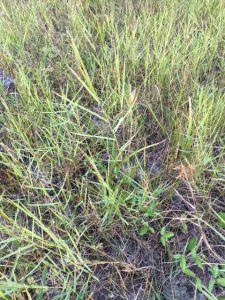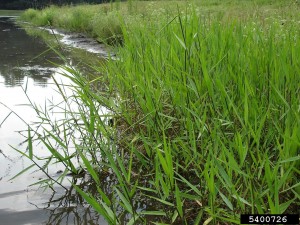
They say the best time to attack an invasive species is early in its arrival. In the early stages is your best chance, using the most cost effective methods, of eradicating an invasive species from a region. Hence our focus on Early Detection Rapid Response (EDRR) list. That is not the case with Torpedo Grass. It is now found in all Gulf coast states and along the Atlantic border to North Carolina. In Florida, it has been reported from 64 of the 67 counties and has also been reported in California and Hawaii. However, it is a problem plant and property owners should try to manage it as best they can.
There is a discussion as to the origins of torpedo grass (Panicum repens). Some say Europe, others Australia, but we do know it is not native to the United States. It was first introduced here in the late 19th century as a forage grass for livestock. Being a tropical-subtropical plant, the introduction was in the southeastern U.S. The young shoots have been selected by forging mammals, livestock and otherwise, but older plants become tough and the livestock ignore them for other species. There are reports of waterfowl and songbirds using torpedo grass as habitat. However, the cons out weigh the pros on this one.
Torpedo grass grows very quickly using underground rhizomes. Though they do produce seeds, these rhizomes, and their fragments, are the primary method of propagation for this plant. It has been found that rhizomes buried as deep as 20 inches can sprout shoots. This aggressive plant spreads quickly, outcompeting native grasses in disturbed areas. They will displace forage grasses that livestock prefer and can inundate a pasture very quickly. Though it is drought tolerant, torpedo grass prefers moist soils and can grow in water as deep as 6 feet. Many property owners have used this grass to control shore erosion but here is where it has causes problems for others. As on land, it grows very quickly. Spreading across shallow waterways making them unnavigable. It has caused problems with irrigation systems, stream flow, and flood control in some areas. It has also invaded citrus groves and gold courses.
So how do we deal with this plant if it is on our property?

Well, we know it is not a fan of cold weather, but we are in Florida; even north Florida is suitable for it. We know it will not survive extreme hot periods. We can only hope that it will get warm enough to knock back large acres of this thing; but warm temperatures like this are not good for most plants in our area – or animals for that matter. There are no known biological controls at this time. So that means we turn to herbicides.
Experience has shown that herbicides alone will knock it back, but rarely eradicates it from the area. Chemicals that have had success are glyphosate and imazapryl. In both cases, an aquatically registered surfactant may be needed for good results. When the torpedo grass is in water, herbicide treatment can be a problem. First, the chemicals used are non-selective and may kill plants you do not want to lose. Second, mats of dead torpedo grass have been known to decrease dissolved oxygen levels (due to decomposition) to levels where fish kills can occur. Some studies have found that burning a field of torpedo grass and then treating with both glyphosate and imazapryl has had some success. Treating first and then burning has not been as successful, nor has leaving one of the three out of the program.
As common and aggressive as this grass is, you may feel any attempt to control is feudal, but doing nothing can be very costly as well. We recommend properties with patches of this grass begin treatments soon, and if you have very little – remove as soon as you can. To learn more visit one of the following websites:
Torpedo grass in Aquatic Environments
Torpedo grass Management in Turf
 0
0
